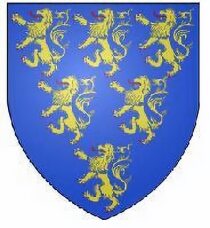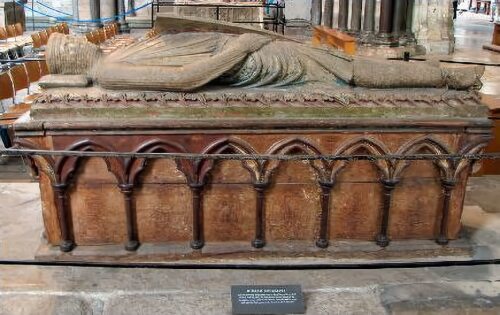She (Idoine) had married William Longsword and attained her majority before June 1226, when the King returned to them the lands of Richard de Camville, who we assume by this time had died. This meant that the lands inherited by Idoine from the Basset, de la Haye and de Camville families were now in the hands of the Longespées, making it a very profitable marriage for William. It is believed that they may have had four children (William, Richard, Ela and Ida), although the only ones well recorded are William and Ela. Idoine died c. 1251, a couple of years after her husband's death at the Battle of Mansor." http://www.lionrampant.uk.com/characters_camville.htm


"Idoine (or Idonea) de Camville was born c. 1209 in Brattleby, Lincolnshire, the only daughter and heir to Richard de Camville, who in turn was the only son and heir of Gerard de Camville and Nicola de la Haye, holders of the castellanship of Lincoln Castle.
The de Camville family came to England with William the Conqueror in 1066 and until the loss of Normandy in King John's reign still held Canville-les-Deux-Eglises, from which they took their name. Richard de Camville's largest estate, and what is believed to be the head or caput of his Barony, was at Middleton Stoney in Oxfordshire although he also held in chief Avington in Berkshire and Godington in Oxfordshire. In 1215 Idoine's mother died and her father sided with the barons in the civil war, despite her grandparent's long standing allegiance to King John. The year after Magna Carta was signed her father had his lands seized by the crown and the castle at Middleton Stoney was destroyed on the King's orders.
Idoine was taken into Royal custody in Corfe Castle where her wardship was sold by the King to William Longespée, Earl of Salisbury. It was arranged that she should be married to his son William Longsword who, like Idoine, was still a child at the time. With her wardship William Longespée obtained the custody of all the lands which belonged to Idoine by right of her mother Eustachia, the daughter of Gilbert Basset, Lord of Bicester.

Tales from the Long Twelfth Century: The Rise and Fall of the Angevin Empire, Richard Huscroft, Yale University Press, 2016
Isabella and Idonia apparently felt that the borough court was overreaching its authority in trying men for murder, a matter that ought to have been considered in the Royal courts and overseen by themselves as co-sheriff's. Isabella and Idonia were unable to perform the office of Sheriff when they were single or married, but her widowhood enabled them the unusual opportunity of doing so. At least two other women acted as Sheriff son 13th century England, too: Nicola de la Haye of Lincoln and Ela, widow of William Longespée, in Wiltshire. The authority exercised by Isabella, Idonia, Nicola de Le Haye, and Ela was unusual, occasioned as it was by their positions as heiresses and widows but it was significant.
Read more: http://mymedievalgenealogy.blogspot.com/2018/02/female-sheriffs-in-middle-ages-nicola.html#ixzz56bhcacRP
Women's Roles in the Middle Ages, Sandy Bardsley, Greenwood Publishing Group, 2007
"This Richard de Camville was also the founder of Combe Abbey in Warwickshire, and a witness to the agreement between King Stephen and the Duke of Normandy, respecting the succession to the crown of England. He died at the siege of Acon in Palestine, having accompanied King Richard the first in his expedition to the holy land. Gerard de Camville, his son and heir, succeeded him, Nicola, daughter and coheir of Richard de la Haye, and became entitled to a large extent of property in this and other counties. For some opposition to the King, and his disloyal conduct, his estates were seized by the crown, and himself was banished the kingdom. He was, however, afterwards pardoned, and his estates restored upon payment of 2000 marks to the King! Richard his son and heir succeeded his father, and married Eustacia, daughter and heiress of Gilbert Bassett, relict of Thomas de Verdon. In the 16th John, 1215, he had livery of part of his paternal inheritance; and 2 Henry III 1219, he had the whole confirmed to him by the King. The issue of this marriage was an only daughter Idonea, who was married to William Longespée, son of the Earl of Salisbury. Upon the death of her father, 10 Henry III 1226, she succeeded to all his estates; and 15 Henry III 1231, her husband had livery of all those lands which had been held of the honor of Camel in this parish, and in Henstridge by Nicola de la Haye, as belonging to his wife Idonea, by hereditary right.
William de Longspee was the son of is celebrated Ela Countess of Salisbury, who served the office of Sheriff in the County of Wilts for several successive years, being the only female to whom such a public office an active charge had ever before been committed. This William de Longespée was slain in the holy war in Palestine by the Saracens, A.D. 1250, and was succeeded by his son and heir William de Longspee, who had livery of his lands 36 Henry III A.D. 1252. He then married Maude, daughter of Sir Walter Clifford, Knt. with whom he had a marriage portion of twenty-eight pounds eight shillings in two pence, a large sum in those days."



No comments:
Post a Comment